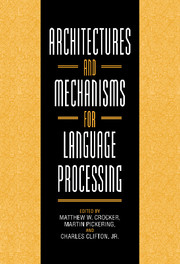Book contents
- Frontmatter
- Contents
- Contributors
- Preface
- 1 Architectures and Mechanisms in Sentence Comprehension
- Part I Frameworks
- Part II Syntactic and Lexical Mechanisms
- 6 The Modular Statistical Hypothesis: Exploring Lexical Category Ambiguity
- 7 Lexical Syntax and Parsing Architecture
- 8 Constituency, Context, and Connectionism in Syntactic Parsing
- Part III Syntax and Semantics
- Part IV Interpretation
- Author Index
- Subject Index
7 - Lexical Syntax and Parsing Architecture
Published online by Cambridge University Press: 03 October 2009
- Frontmatter
- Contents
- Contributors
- Preface
- 1 Architectures and Mechanisms in Sentence Comprehension
- Part I Frameworks
- Part II Syntactic and Lexical Mechanisms
- 6 The Modular Statistical Hypothesis: Exploring Lexical Category Ambiguity
- 7 Lexical Syntax and Parsing Architecture
- 8 Constituency, Context, and Connectionism in Syntactic Parsing
- Part III Syntax and Semantics
- Part IV Interpretation
- Author Index
- Subject Index
Summary
Introduction
Traditionally, accounts of cognitive abilities have proposed inherent restrictions on cognitive architecture as the underlying cause of observed patterns of human behaviour. Models of the human sentence-processing mechanism (HSPM) have largely fallen within this architectural paradigm, attributing interpretation preferences and processing breakdown to limitations on computational resources or on the interface between cognitive modules (e.g., Crocker, 1992; Frazier and Fodor, 1978; Gibson, 1991; Lewis, 1993; Marcus, 1980). Recently, in conjunction with advances in connectionism, research in cognitive modelling has seen a surge of interest in the role of environmental factors in determining crucial properties of intelligent behaviour. In contrast to a highly constrained underlying architecture, relatively unrestricted cognitive mechanisms are proposed, whose precise behaviour is determined by their adaptation to specific experiences. Within sentence-processing research, this approach is exemplified by the constraint-based paradigm (e.g., MacDonald, 1994; MacDonald, Pearlmutter, and Seidenberg, 1994; Spivey-Knowlton, Trueswell, and Tanenhaus, 1993; Trueswell, 1996; Trueswell, Tanenhaus, and Garnsey, 1994; but see also Mitchell, Cuetos, Corley, and Brysbaert, 1995), which proposes that exposure to the linguistic environment, rather than internal architectural properties, is primarily responsible for the specific behaviours of the HSPM. In constraint-based models, individual lexical entries play a central role as the repository of experiential knowledge, and lexical frequencies are a primary determinant of human behaviour. In particular, the operation and outcome of the HSPM are determined almost entirely by the differential frequencies among alternative interpretations.
In contrast to this recent trend, we have argued that restrictive architectural assumptions are necessary to an explanatory account of the HSPM (Stevenson and Merlo, 1997).
- Type
- Chapter
- Information
- Architectures and Mechanisms for Language Processing , pp. 161 - 188Publisher: Cambridge University PressPrint publication year: 1999

